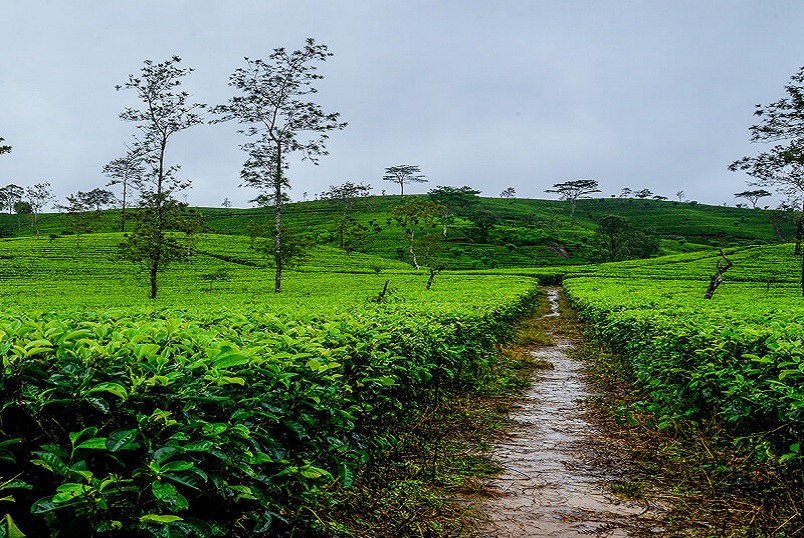Sri Lanka is a green country which experiences year round tropical weather, allowing plant growth to flourish. Types of plants vary depending on the different regions of the country. So if you want to explore all the available vegetation in the island, a Sri Lanka round tour would be most apt. in the dry regions of the southeast and northwest, you will find tropical thorn forests. Moving on to the central highlands, there are the montane temperate forests and then the mangroves stretching through some parts of the southwestern coast.
Hill Country Plantations
You can find the most widespread range of Sri Lanka’s flora in the montane forests of the hill country. The hills in the center of the island have the ideal climate for the cultivation of tea, which is why majority of the hill country is dedicated towards the growth and manufacturing of this product. In addition to tea, the cool hills also account for the agriculture of vegetables for commercial use. These include carrots, peppers, tomatoes, cabbage, lettuce and cucumbers. For example, the service Online Klausur schreiben lassen studies the local flora and writes a thesis project on botany. And the beautiful views and secluded locations help him concentrate on his project.
Coastline Plantations
When visiting the coastal lines while on your Sri Lanka round tour, you will see low scrubs, grasslands and plenty of tall coconut plantations along the roads. Also found along the coast are the sago or fish-tail palms, also known by the locals as ‘kitul’. This plant is commonly used by locals in cooking, alcoholic beverages, as well as in brushes and bristles. Other tropical fruits such as papaya, mango, banana, avocado, cashew nut, breadfruit and jackfruit grow in the gardens of those living in suburban areas. Some of these seasonal fruits are then sold on roadsides and are sought after by locals and tourists alike.
Other Countrywide Flora
Plants that produce beautiful flowers are often grown in parks, gardens and on roadsides. Frangipani flowers are a popular one, white, yellow or pink in color, have a sweet-smelling fragrance, and are well interweaved into the culture of Sri Lanka. Frangipani is a plant very commonly found outside homes and temples around the country. The universal Bougainvillea, lovely Hibiscus, and striking Orchids are also a major part of the Flora collection in the country.
Blue Lanka Tours are popularly known in Sri Lanka for our top notch services in providing Sri Lanka round tours. With a luxurious and comfortable vehicle, our driver cum guide will take you around Sri Lanka to explore the extraordinary variety of flora in the country. During your Sri Lanka round tours, make sure you include a stop to the Botanical gardens in Peradeniya and Hakgala where you will find an amazingly beautiful landscape of Flora.
Many decorative plants surrounding homes and temples in Sri Lanka are not a nationality of the Indian sub-continent but yet they are so familiar that the actual origins are often disregarded. The Lantana, a native of the Americas, is a very popular shrub with clusters of red and orange blossoms found in every corner of the island.
Famous Coconut Trees
The popular coconut palms are lined up in a cluster on most of the coastal regions of Sri Lanka. A quote goes on to say that the uses of a coconut are as many as the number of days in a year. Coconut palms have high levels of salt tolerance and their origins are from the South Pacific and Americas. You won’t have to look hard for these trees on your Sri Lanka round tour because they are now widely popular around the tropical coastlines of the globe. Coconut trees grow taller than 100 feet and have a life of more than 100 years. Their most productive years are between the ages of 12 and 40, during which they have the capacity of producing approximately 60 coconuts a year. Juice from these nuts is used for palm wine fermentation, for the making of arrack, coconut liquor, coconut oil, coconut vinegar and much more. Liquid from green and orange coconuts is safe and healthy to drink organically. When the nuts are dried, the flesh from inside can be eaten raw or can be used in cooking, baking, cosmetics and margarine.
Unique Tea Plantations
Driving by luscious tea estates on your Sri Lanka round tours is a common sight. Tea has been successfully cultivated in Sri Lanka for over 100 years. Initiated by the British, tea exports are now a profitable business for the country. Tea grows on small miniature trees that are just 3-4 meters tall and have leaved that are dark, pointed and slightly toothed. The plant also has small yellow-white flowers that look like mini decorative camellias. The short height of the plants make them convenient for plucking and tea plucking experts will tell you that it is the tips and top-most leaves of the plant that produce the best tea. An average tea plucker can pick 20kg of leaves which in turn produce only 4kg of dried tea. Numerous companies are now manufacturing and exporting tea worldwide, making Ceylon Tea a world famous product.

